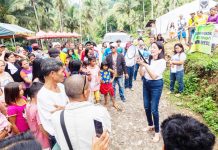A 300-bed capacity drug rehabilitation facility for “severe cases” located in Barangay Malagos, 36 kilometers away from the Davao City proper, is targeted for completion and opening this coming May.
Health Undersecretary Roger P. Tong-An said the facility will cater to all drug dependents and drug surrenderees screened as “severe” in Region XI.
“Doon natin dadalhin yung severe cases that needs rehabilitation for at least six months,” Tong-An said.
He said they Department of Health is now preparing for the staff under the leadership of DOH Regional director. He said the facility, which is being constructed through a grant from an NGO, will be run by the DOH.
Tong-An said the Malagos rehab center is one part of 10 grants extended all over the country. He said in Mindanao there are three grants (one in Malagos for Region 11, one in General Santos, one in Sarangani Province and one in Bukidnon. The Bukidnon facilitiy is the biggest housing a total of 700 beds. The other centers are located in Luzon and Visayas.
DOH is part of the Inter-agency Commitee on Anti-illegal Drugs (ICAD) to suppress the drug problem in the country. Tong-An said the DOH will come in after the Philippine National Police (PNP) and Philippine Drug Enforcement Agency (PDEA) conducted the anti-drug operation “Tokhang” in certain barangay through Barangay Anti-Drug Abuse Council (BADAC), which is considered as the first line of defense against the proliferation of prohibited drugs in the community. Tong-An said the DOH’s nurses, psychologists and trained physicians together with the Barangay Health Workers (BHWs) will screen those drug dependents that voluntarily surrendered.
“According to WHO admission of drug surrenderees are 95% within the community based at ito yung aggawin ng BADAC or ADAC titipunin sila at darating ang DOH that will screen whether their cases are mild moderate or severe. We will just treat them as an ordinary disease and we will just manage them. ,” he said.
He said those who were screened as “mild” or “moderate” will be rehabilitate in the community based center while those who were screened “severe” will be admitted to a rehab center.
Tong-An said in between the community based and rehab center they will be piloting recovery clininc or halfway houses wherein drug dependents will be given livelihood programs via various government agencies such as the Department of Agriculture (DA), Technical Educational and Skills Development Authority (TESDA), and Commission on Higher Education.
“Before they will be released to the community meron na silang pangkabuhayan and at the same time through TESDA and CHED dropouts will receive diploma paglabas sa halfway house going to the community,” he said.
He said the community integration will be handled by the Department of Social Welfare and Development (DSWD).
Dangerous Drug Board (DDB) chair Secretary Catalino S. Cuy said it is not enough to just rehab the drug dependents as it is also important to re-integrate them to the community to make them useful and productive member of society.
“Re-integraton and rehabilitation should go together. In rehabilitation they are being prepared for their re-integration in to the society,” Mr. Cuy said.
Department of Interior and Local Government (DILG) Assistant Secretary for External and Legislative Affairs Ricojudge Janvier M. Echiverri said ICAD is now focusing on the preventive side and protect those whoa re being influenced to drugs.
“Ang aming effort ay hindi lang puro enforcement ICAD now is focusing on the preventive side meaning hindi lang puro huli and rehab. So the preventive measures should be stronger. Japan for thatr matter has given more funds for prevention rather than law enforcement and rehab kasi ang goal namin in the years to come wala na dapat i-rehab at wala na dapat addicts,” he said.
He said the PDEA is coming up with more policies on how DepEd and CHED and shools can teach the ill effects of drugs to the youth.






